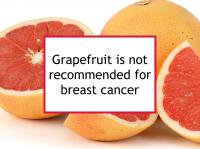Grapefruit (Citrus paradisi) has been found to have antioxidant, antiseptic, neuroprotective, and sedative actions. Although components of grapefruit peel have been found to reduce blood pressure, pink grapefruit juice appears to have proarrhythmic actions which might be of concern for some heart patients.
Pink grapefruit is a good source of naringenin, beta-carotene, ferulic acid, lycopene and vitamin C. White grapefruit is not a source of beta-carotene or lycopene, which give pink and red grapefruit flesh its color. Grapefruit peel is a very good source of D-limonene, and incorporates some hesperidin and tangeretin.
Naringenin has been shown to have cytotoxic activity against leukemia, stomach, colon, liver, pancreas, cervix, and breast cancer cells. D-limonene, the D isomer of limonene, has been used clinically to dissolve cholesterol-containing gallstones and for the relief of heartburn and gastroesophageal reflux disease. In addition, D-limonene has been shown to inhibit the proliferation of human colon cancer cells.
Pomelos (Citrus maxima) are large citrus fruit native to Southeast Asia that are similar to grapefruit. Pomelos have the same potential for adverse drug interactions as grapefruit.
Melanoma warning
Several studies have reported that people with diets high in citrus, including grapefruit, may be at increased risk of malignant melanoma, possibly from ingesting photosensitizing compounds called psoralens found in citrus fruits.
Breast cancer-related effects of eating grapefruit
Various grapefruit phytochemicals have been shown to have chemopreventive effects with respect to breast cancer cells. However, epidemiological studies have not found a protective effect for grapefruit.
Naringenin
Naringenin has cytotoxic activity against both ER+/PR+ and triple negative (ER-/PR-/HER2-) breast cancer cells. For example, naringenin has been shown to inhibit the proliferation of ER+/PR+ breast cancer cells by impairing glucose uptake. Naringenin has also been shown to inhibit ER+ breast cancer cell growth and migration in the presence of estradiol (E2).
However, there is evidence to suggest that grapefruit may play an unwelcome role in estrogen metabolism (in much the same way that drug interactions occur with grapefruit), thereby increasing circulating estrogen and breast cancer risk.
Limonene
Limonene, a cyclic monoterpene, and its D isomer D-limonene, are found primarily in citrus peels, but may also be present in grapefruit juice, depending on how it is prepared. Limonene has been reported to have chemopreventive effects with respect to breast cancer, but the evidence is limited compared to that of other citrus micronutrients. However, D-limonene has been reported to reduce the treatment effects of paclitaxel.
Human studies
One major population study found no association between grapefruit intake and the risk of breast cancer. Another major epidemiological study reported that grapefruit consumption was associated with increased risk of breast cancer among postmenopausal women. Still another study of postmenopausal Mexican-American women found that consumption of grapefruit was associated with higher circulating estrogen levels. Each of these studies was published during the period 2007 to 2009; more recent research is not available.
Avoid grapefruit during systemic treatment
Grapefruit juice can affect the metabolism of many drugs, in some cases increasing their effect and in other cases blocking their intended action. Drug interactions have been observed between grapefruit and albendazole, amiodarone, atorvastatin, buspirone, carbamazepine, cisapride, cyclosporine, diltiazem, etoposide, felodipine, lovastatin, midazolam, nitrendipine, nimodipine, nisoldipine, quinidine, sertraline, simvastatin, terfenidine, and triazolam, to name only a few of the drugs affected. The effect can vary considerably from person to person, so that the extent of the impact of consuming grapefruit juice on drug metabolism is not predictable.
Grapefruit should not be consumed during chemotherapy, trastuzumab (Herceptin) treatment, or treatment with anti-estrogens such as tamoxifen and aromatase inhibitors (anastrozole (Arimidex), letrozole (Femara), or exemestane (Aromasin)).
Bottom line
While the results of both population-based and laboratory studies concerning grapefruit are not entirely consistent, there is enough evidence to suggest that grapefruit consumption should be limited or avoided by breast cancer patients and survivors, especially those with ER+ disease or undergoing treatment.
Sources of information provided in this webpage
The information above, which is updated continually as new research becomes available, has been developed based solely on the results of academic studies. Clicking on any of the underlined terms will take you to its tag or webpage, which contain more extensive information.
Below are links to 20 recent studies concerning this food and its components. For a more complete list of studies, please click on grapefruit.
